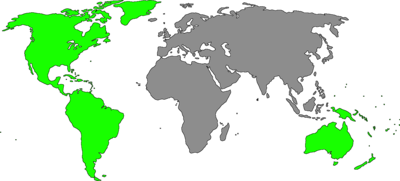New World

The New World is one of the names used for the Western Hemisphere, specifically the Americas. When the term originated in the late 15th century, the Americas were new to the Europeans[note], who previously thought of the world as consisting only of Europe, Asia, and Africa (collectively, the Old World). The term "New World" should not be confused with "modern world"; the latter generally refers to a historical period, not a landmass.
^ Note: Portions of Northern America were not unknown to the European Scandinavians before the 15th century. Greenland was discovered in the late 10th century by Scandinavians, and what is now Canada a few years later — see the Viking expansion.
Name origin
In 1492, Christopher Columbus returned from his first voyage to the Americas, stopping first in Portugal and then traveling to Spain. On 1 November that year Peter Martyr d'Anghiera referred to Columbus in a letter as the discoverer of "the New World" (novi orbis).[1] In a subsequent letter a year later he again referred to "the New World" (orbo novo).[2] In 1516, Martyr published a work whose title began De orbe novo ("On the New World").
In 1524, the term was also used by Giovanni da Verrazzano in a record of his voyage that year along the Atlantic coast of land that is now part of the United States and Canada.[3]
Currently, one might speak of the "New World" in a historical context when discussing the voyages of Christopher Columbus, the Spanish conquest of Yucatán, and other events contemporaneous to the term; additionally, the term "New World" is sometimes used in a biological context, when one speaks of Old World (Palearctic, Afrotropic) and New World species (Nearctic, Neotropic).
While the term "New World" always encompasses the Americas, the islands of Oceania may only be described as "New" in certain contexts (e.g. New World wine). In a biological context, these islands are neither New World nor Old, as flora and fauna differ markedly from those of Eurasia, Africa and the Americas.[citation needed]
See also
References
- ^ O'Gorman, Edmundo (1961). The Invention of America, p. 84.
- ^ Zerubavel, Eviatar (2003). Terra Cognita: The Mental Discovery of America, p. 72. Citing: Thachohn B. (1903). Christopher Columbus, vol. 1, p. 62.
- ^ Verrazzano, Giovanni da (1524). "The Written Record of the Voyage of 1524 of Giovanni da Verrazzano as recorded in a letter to Francis I, King of France, July 8th, 1524". Citing: Wroth, Lawrence C., ed. (1970). The Voyages of Giovanni da Verrazzano, 1524-1528. Yale, pp. 133-143. Citing: a translation by Susan Tarrow of the Cellere Codex.











